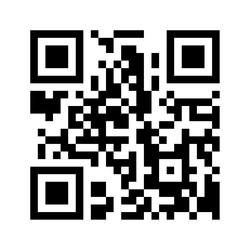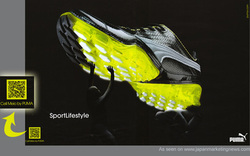
First released in 1994 and winner of the 2012 Media for Industry category of the `Good Design Award`[1] , Quick Response Codes made their mark in business (and the publishing industry was no exception), over a very short amount of time.
The phrase "necessity is the mother of invention" is no less true when it comes to QR codes. Before they came about, traditional barcodes were found to be very lacking when it came to storage space. This is because they only had the capacity to store 20 or so alphabetical characters of information which, whilst they made the lives of numerous cashiers significantly easier, was simply not enough a lot of the time.
And so along came Masahiro Hana who - unlike many other 2D code developers who were trying to cram as much space as possible into their codes - realised that it was more about general speed efficiency. The distinctive pattern is no random accident; the squares in each corner are specifically designed to maximise the response time of whatever device is trying to interpret the code. Known as a "position detecting pattern", the design was created by doing an exhaustive survey into business documentation, looking for common patterns and researching which colours and shapes do not appear very often. Using this information Masahiro was able to create the optimal code for fast and easy recognition by enabled devices. And thus, the Quick Response code was invented.
In addition to this speed efficiency and high storage space, QR codes also have the advantage of dealing with damage/loss of data very well. Using its error correction capability, the codes are able to restore up to 30% of lost data depending on what level the user chooses, at the expense of code size[2].

QR codes are a way of making things more convenient, and this is the primary reason as to why their popularity has grown so exponentially. They have uses in manufacturing, retail, warehouses, medicine and many other services. Publishing is no exception here. Publishers want to stand out and engage users as much as possible, and QR codes are a way of establishing a bridge between offline and online media[5]. QR codes can transform a printed page into a 3D interactive screen with the right program and their uses seem limitless.

They have great uses in advertising as well, allowing the audience to learn more information about a product without said information filling the advertisement for example.
One potential disadvantage of QR codes is that one needs to have the correct reader software on them in order to actually interpret the code,[6] which is currently only available on smartphones. However this technology is pretty much standard on any device being brought out these days, due to the strong presence that QR codes have in today's world.
In conclusion then, QR codes are an extremely efficient form of data storage and transformation and have with good reason become standardised in all areas of business.
Word count: 602
[1] QR Code history: http://www.qrcode.com/en/history/ - Accessed 20/10/2013
[2] Error correction: http://www.qrcode.com/en/about/error_correction.html - Accessed 20/10/2013
[3] Code size: http://www.qrcode.com/en/about/ - Accessed 20/10/2013
[4] Micro codes: http://www.qrcode.com/en/codes/microqr.html - Accessed 20/10/2013
[5] Bridge between media: http://qfuse.com/learn-more/publishers-of-magazines-newspapers-catalogs-newsletters - Accessed 20/10/2013
[6] Disadvantages of codes: http://www.robabdul.com/QR-Code-advantages-and-disadvantages.asp - Accessed 20/10/2013
QR Code image: http://www.qrstuff.com/images/sample.png - Accessed 20/10/2013
Advertising image: http://www.japanmarketingnews.com/images/2008/09/10/japan_puma_ad_qr_code.jpg - Accessed 20/10/2013
 RSS Feed
RSS Feed